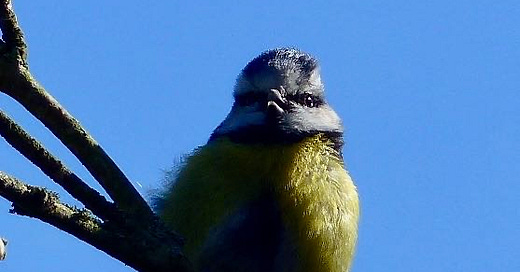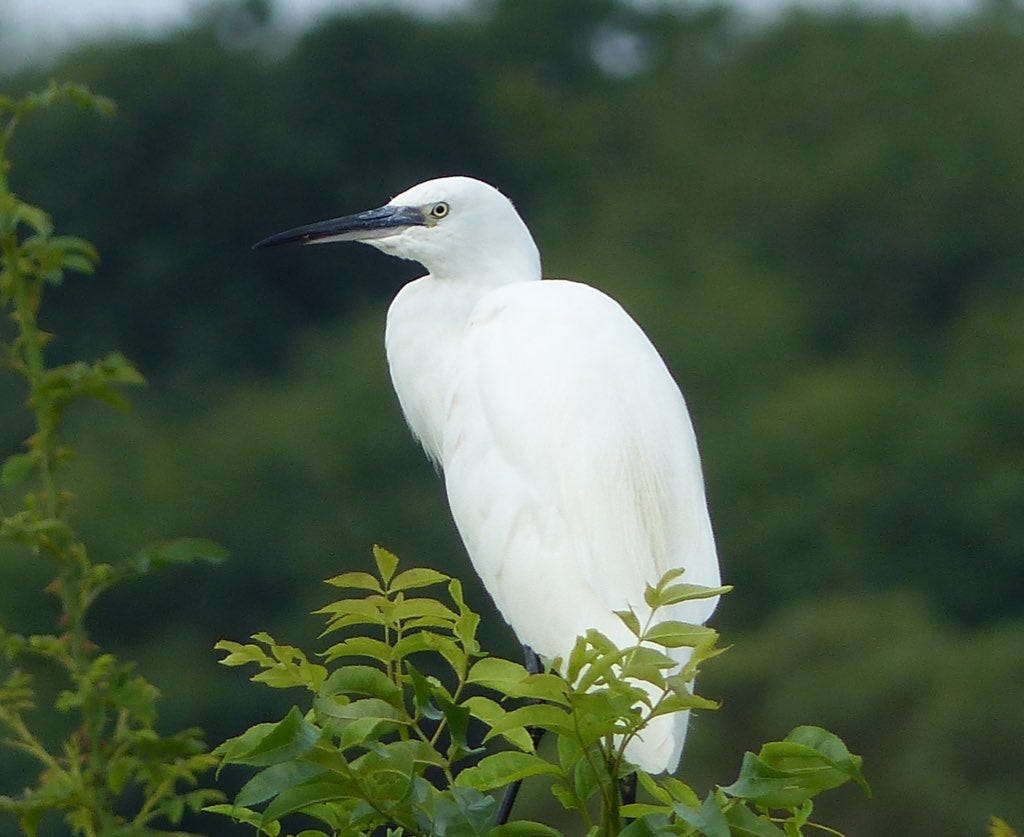The Year of 100 Birds – Week 2
On The Ice | Blue Tit | Little Egret | Slow Wren | Parakeets
Hello. Welcome. Thanks for being here.
Every week in 2025, as well as the regular Six Things posts, I’ll be writing about birds. If birds aren’t your thing, perhaps I can lure you into their evil world. And if no absolutely not, then you can always toggle your preferences so you only get what you want.
For those who stay, there will be:
– a bit about my birding activities that week
– micro-essays about two British birds
– a couple of news-y or science-y or otherwise of interest bits from elsewhere
I hope you enjoy it all.
On The Ice
Once a month, I take myself to Mitcham Ponds in south London, there to count birds for the British Trust for Ornithology’s Wetland Bird Survey (WeBS). The survey consists of thousands of regular observations, each one a tiny dab on the canvas. Stand far enough back and the big picture takes shape.
My role in this ongoing population monitoring is tiny, a drop in the data ocean. And it’s not a large undertaking. Advanced WeBSers have responsibility for large swathes of estuary or mudflat, counting thousands of birds of many species. Birds being birds, with all their flying around and such like, it’s a tricky operation best executed only by the experienced. My brief, on a smallish urban pond, is more straightforward. To be blunt, it’s mostly sitting ducks.
Today, though, it’s shaping up to be the simplest task ever. There are no birds. Instead, an expanse of ice, on which two boys are playing. My instincts, finely tuned by repeated exposure to icy peril scenes in the movies, scream “no no get off”. But the ice is solid, and the boys are closely monitored by their father, who keeps a very close eye on them while seeming not to, all the while exuding an aura of insouciant calm. Nice trick if you can pull it off.
But if there is ice on the pond, and boys on the ice, where are the birds?
Round the corner, huddled by the central island in the only unfrozen patch, that’s where. Sixty-one mallards, eight coots, six moorhens, four Egyptian geese and two shoveler, since you ask.
Most of them are in the water, their enforced closeness prompting low-grade unrest. Occasionally this triggers a squabble, a brouhaha, or, worse, a fracas. One such disagreement sends a mallard out of the water and sliding across the ice like a feathery curling stone. It comes to a halt, assesses its options, and chooses to stay put, standing on one leg and tucking its beak under its wing in time-honoured ducky fashion.
There are many differences between us and ducks, but perhaps the least remarked-upon is the counter-current heat exchange system in their legs. A counter-current heat exchange system is very clever: it stops their feet from going cold when they stand on ice.
It works something like this.
Warm arterial blood goes down from the body into their narrow legs. Next to the arteries are the veins ferrying the blood back from the feet. That proximity means the warm blood warms the cool blood and the cool blood cools the warm blood, so the blood in the feet – and I realise this isn’t the most elegant explanation of anything you’ll ever read – is smack bang in the Goldilocks zone vis a vis its prevailing temperature. No cold feet, thanks to the counter-current heat exchange system. I’ll have two, please.
I count the birds, enjoy their company for a few minutes, then leave. The world this early morning is crystalline and magical, everything coated in brittle ice dust, the weak rising sun jaundice-yellow on Struwwelpeter trees. I crunch through the grass. A kestrel eyes me from the top of a nearby tree. It’s probably been eyeing me for a while – kestrels can spot a vole a mile away, and voles are small and unclunky – but I am slow on the uptake, and just seconds after I register its presence it’s off, unpeeling smoothly from its perch and flapping away, unhurried, a pale ghost in a frozen ghostly world.
The Blue Tit
They’re so familiar you could easily dismiss them.
“Oh yeah, a blue tit.”
Rewind. Look. Look again.
Quite apart from the vivid plumage – as an Oxford United fan since childhood I’m particularly disposed to enjoy that particular combination of blue and yellow – there’s the energy. Absolutely fizzing, from perch to feeder. An electric bird. Throw in the acrobatics – they hang UPSIDE DOWN – and the blue tit is watchability birdified.
I was aware of them from an early age. Not just because of their ubiquity at the feeding table, but also because of top of the milk.
We had a five-minute window. Five minutes from the first sound of the milk float – soft whine of battery, bottles rattling in their crates – to make sure the precious cargo was safely stowed in the fridge. Because if we didn’t, the birds would be in there. And the blue tits were the masters. Usually the first to descend, they pecked little holes in the golden foil tops and drank as deeply as they could from the creamy ambrosia beneath. I read a few years ago that in their desperation to reach that last bit of cream, some birds fell in and drowned. RIP blue tit – greed, as is so often the case, was your downfall.
It dated from the 1920s, this practice. Back then the bottle tops were made of waxed board, not tin foil, but the birds, determined and inventive, somehow knew that beneath the hard barrier lay rich reward. By the 1940s, birds up and down the country were doing it. And come the 1970s it was assumed.
With the general demise of top of the milk – and the more widespread use of supermarket-bought cartons and plastic bottles replacing the familiar milkman of many childhoods – the practice died out. By the 1990s there were fewer bottles on doorsteps, and those that remained most often held only milk (brimming with lactose, which birds lack the enzymes to process), not cream (relatively lactose-free). And so ended a brief, golden age of avian pilfering.
They’re still familiar, of course, their flitty belligerence a staple of bird feeders and nest boxes up and down the country. While any crevice will do for nest-building, it’s undeniable that a nestbox is convenient. And with the nestbox webcam ever more prevalent, we can watch the process from the comfort of our offices. The building of the nest is diverting enough, but a large brood only adds to the entertainment, the parents rushed off their feet to provide enough food (hundreds of caterpillars every day) for those wheedling, hungry mouths. By the end of the breeding season the poor parents are knackered and worn out – spare them a thought when you see a blue tit at the feeder in August.
ID: small, flitty, busy. Yellow underneath, blue or blue-green above. Delicate black lines on white face.
Where: gardens, woodland, parks throughout Britain.
Sounds: two or three tsreeps then a series of lower, faster notes; strident tccchhhhhrrrrrrrrik.
Further reading:
Jennifer Ackerman – The Genius of Birds
The Little Egret
You always remember your first.
Mine was slopping around in the mud – right there in front of me, absolutely shameless – as I sat in a freezing hide at RSPB Minsmere. It was my first visit to that birding Mecca since childhood, when a Little Egret sighting would have been on a par with unicorns. It sat alongside whiskered tern, alpine accentor and scops owl in the “visitors from south-west Europe and Asia” portion of my Reader’s Digest Book of British Birds – intermittently recorded over the centuries, but not for the likes of you, Sonny Jim.
White birds – pure, blemish-free detergent advert white – are relatively few. Swans, obviously; the odd pelican; ptarmigans in winter plumage, perhaps; and several egrets. The colouring is deceptive. No innocents, these. Not to be trusted, especially if you’re a fish. Whether stalking through the silt or stirring it with their feet in the hope of rousing some prey, they’re what the books describe as “highly opportunistic feeders” – field guide code for “will have anything that moves”. The wiry neck launches a fearsome stab, and the dagger beak is sharp. RIP stickleback.
Those white feathers, and especially the pair of long fluffy filaments that spring from the nape, were catnip to the fashion industry back in the day. In the 19th century, at the height of the global frenzy for bird plumes as part of human costume, egret feathers fetched top dollar, at one point up to 28 times more valuable by weight than silver. Birds were destroyed in massive numbers to feed the industry. In 1887 a single dealer handled over two million egret skins. Two years later, hoping to stem the tide of cruelty, a group of women in Didsbury formed the Society for the Protection of Birds. Over 135 years on, it is the largest wildlife conservation organisation in Europe.
A warming world has seen the little egret’s range expand rapidly. The first British breeding record, on Brownsea Island in Poole Harbour, was in 1996. Five years later the total of breeding pairs passed 100. And now if I don’t see one whenever I’m near an estuary or a marsh I get a bit shirty. What a state of affairs. From extremely rare to commonplace in half a human lifetime. But whatever their population status, I'll always give a bit of time to the Persil-plumaged foot-stirrers.
ID: pure white; smaller and daintier than a heron; black legs, yellow feet, most likely seen trailing behind when in flight.
Where: estuaries, marshes, riverbanks, mud. Nest in trees.
Sounds: not many, really, but occasionally croaky at breeding sites.
Further reading:
Tessa Boase – Etta Lemon: The Woman Who Saved The Birds
Slow Wren
Thanks to Charlie from Shriek of the Week (if you’re not already signed up to it, what are you waiting for?) for this: a wren’s song slowed down.
Parakeets
At some point in this survey of 100 British birds I’ll write about the Ring-necked Parakeet. But I won’t be able to match this wonderful piece by Tim Dee.






Struwwelpeter trees and Persil-plumaged foot stirrers. Love it.
I like your comment about the Little Egret. Like you, the first one I saw was amazing and so memorable. Not they're everywhere. Other birds have also crept up on us. I didn't see a buzzard until the 2000s and on my regular train trips to London would avidly stare out the window hoping to see one. Now they are everywhere, there is a resident pair in my neighbourhood who successfully raised a chick last year. Collared Doves are another one. Marvellous.